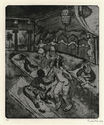
19th, 20th & 21st Century Fine Prints
707-546-7352 · fax 707-546-7924 · web: www.annexgalleries.com · email: artannex@aol.com
Max Pechstein Biography
Max Pechstein
1881–1955
Biography
Painter and printmaker Hermann Max Pechstein, known professionally as Max Pechstein, was born in Zwickau, Germany, on December 31, 1881. His father, a craftsman, worked in a textile mill, and Pechstein was inspired from an early age to pursue visual arts. He trained as a decorator with a local company before enrolling at the School of Applied Arts in Dresden, followed by the Royal Art Academy, where he studied under Otto Gussman. Of particular interest to Pechstein was the work of Vincent van Gogh and the rise of the genre that would later be labeled Expressionism.
In 1906 Pechstein was invited to join the group Die Brucke, a German Expressionist art association founded the year prior by Fritz Bleyl, Erich Heckel, Ernst Ludwig Kichner, and Karl Schmidt-Rottluff. He was the only artist in the group with formal training. After traveling throughout Italy and Paris, Pechstein moved in 1908 to Berlin, the metropolitan city fast becoming a hub of creativity, despite the conservative moors of its leading salons. He was rejected from participation at the Berlin Secession in 1910 due to the anti-academic undertones of the Die Brucke sensibilty, prominently portrayed in his work. In response, he and artist Georg Tappert founded the New Secession, a brief-lived but important association that helped to bring German Expressionism into the forefront of the Eastern European art world.
Pechstein's style soon recieved more widespread acclaim, owing to the evolution of his work into a more decorative bent, borrowing from van Gogh and the Fauvist genre. This would prove untenable by the rest of the New Secessionists and he was expelled from the group. Pechstein, having already felt more conservative than his peers, did not mind the expulsion; rather, he took the opportunity to travel alone and explore the primitivist style he admired, finding his way to Palau for inspiration. However, trouble arose as Europe began preparing for war, and Pechstein was interned in Japan before being sent to the Western Front in 1916.
Once he was discharged, and despite his relatively conservative leanings prior to the war, Pechstein joined the Arbeitsrat fur Kunst artist's union and the November Group for artists and architects, both radical socialist groups, somewhat short lived but no less influential. These associations were frowned upon by the growing conservative, nationalistic movements of interim-war Germany. Pechstein had taken a position at the Berlin Academy in 1922; one decade later, he was banned from exhibiting his art in Germany and subsequently fired from the school. His extensive oeuvre was removed from every museum and gallery in Germany and sixteen of his works were exhibited at the infamous Entartete Kunst (Degenrate Art) exhibition held by the Nazi Party in 1937. By then, however, Pechstein had gone into hiding in Pomerania. He remained there until after the war.
In 1945, as with many surviving art teachers whose portfolios and jobs had suffered the same fate, Pechstein was given back his position at the Berlin Academy, and was given several awards for his work. The prolific artist had creasted 421 lithographs, 315 blockprints, and 165 intaglio prints. Additionally, he added to his body of 326 pre-war paintings, some of which were never recovered. He died in West Berlin on June 29, 1955.

